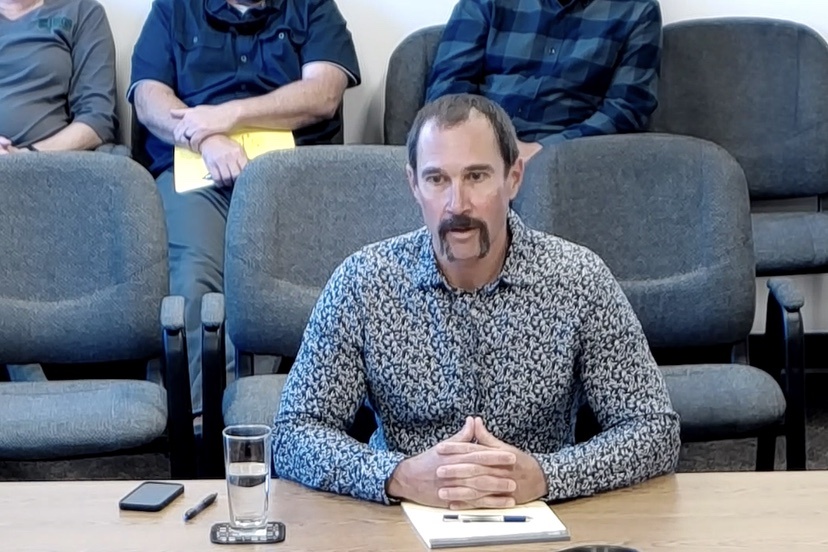Photo: Attorney Jeff Kane, representing the San Juan Water Conservancy District at the October 10 meeting of the Southwestern Water Conservation District.
When people in Pagosa Springs are asked about their concerns for the future, “water availability” is often mentioned as one of those concerns. This fear is not typically based on an experience of an actual water shortage here in our community, however. It’s more likely to be based on media reports of drought and declining water supplies elsewhere… in Arizona, perhaps, or in California.
I’ve often argued, in these pages, that Pagosa Springs has some of the most secure access to water in the American West, located as we are at the very base of mountains typically piled high with snow during the winter, and subject to “monsoon seasons” during the summer.
Some people are not swayed by my arguments.
On October 10, the weekly Pagosa Springs SUN shared a well-written story by reporter Josh Pike, summarizing the ongoing discord between two local water districts — the Pagosa Area Water and Sanitation District, and the San Juan Water Conservancy District — regarding a potential sale of the 667-acre Running Iron Ranch. The two district cooperated on the purchase of the ranch in 2008 as the site for a future water reservoir, but have more recently had differences of opinion regarding the feasibility of financing and building the reservoir.
And regarding the need for the reservoir.
The PAWSD customers are currently paying off a $9.2 million loan used to purchase the property. SJWCD does not have any obligation to pay towards the loan, but is still listed on the deed as part-owner of the property.
Disclosure: I currently serve as a volunteer on the PAWSD Board of Directors, but this editorial reflects only my own opinions, and not necessarily the opinions of the PAWSD organization as a whole.
I’m using two very similar acronyms in this story, and I hope readers do not confuse them. The Southwestern Water Conservation District — SWCD — serves 9 Colorado counties. The San Juan Water Conservancy District — SJWCD — serves the urban-suburban core of Pagosa Springs. The difference is a “J”.
One of the strategic goals of the Southwestern Water Conservation District — SWCD — is to “support investment in improvements to existing infrastructure as well as the development of new infrastructure for multiple uses in southwest Colorado…” SWCD annually distributes about $600,000 in grant funding to various organizations, with some earmarked for existing or new infrastructure. One recent project that received SWCD grant funding involved emergency repairs to the Beaver Creek Ditch in Montezuma County, which received about $115,000 from SWCD.
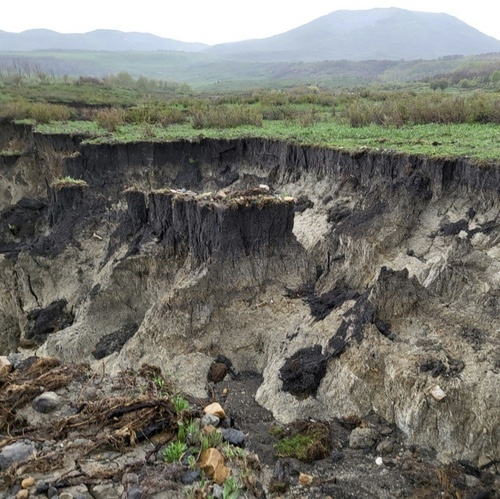
Another project along the Dolores River, involving the removal of a water-thirsty non-native shrub called tamarisk, and the planting of native vegetation, received a grant of about $20,000.
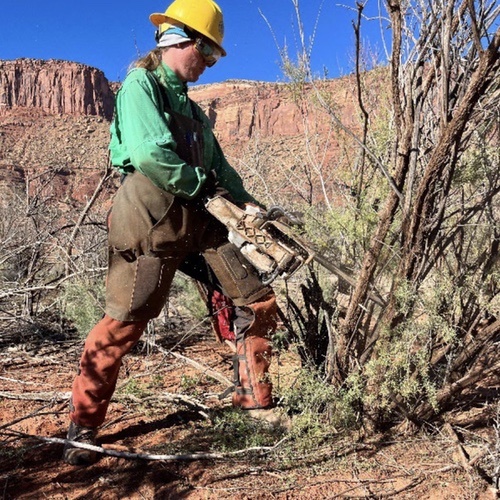
The annual budget for SWCD is about $2 million, almost all of which comes from property taxes collected from the nine counties served by the District.
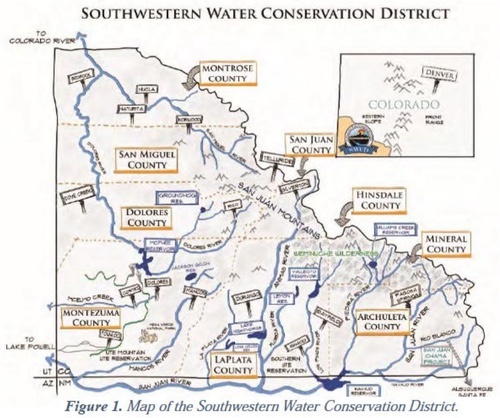
At last week’s SWCD Board meeting, attorney Jeff Kane made a presentation on behalf of SJWCD. He didn’t have a specific “ask” but said he mainly wanted Southwestern to be updated on the possible Running Iron Ranch sale. He began by sharing a brief outline of the situation, including the following map showing the considerable overlap of the two districts, with the PAWSD district shown in pale green and the somewhat larger SJWCD district — which includes the PAWSD district — in pale purple.
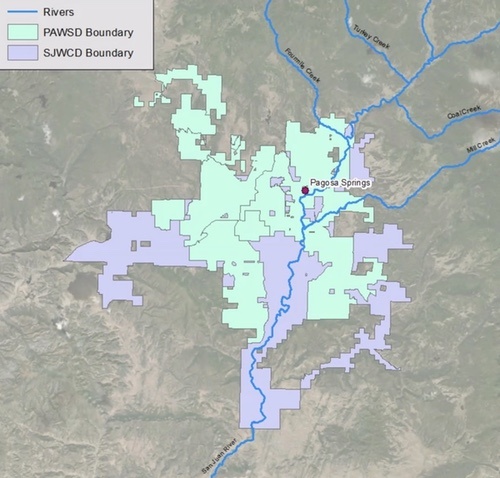
Unlike some recent comments made by SJWCD President Candace Jones regarding the proposed sale of the Running Iron Ranch, I found attorney Kane’s presentation to be fair, measured and non-confrontational, even if I didn’t necessarily agree with his conclusions.
For example:
Mr. Kane showed the SWCD Board a graph taken from a controversial study of projected future water needs, written by consultants Wilson Water Group (WWG) on behalf of SJWCD. The SJWCD Board accepted this study in 2022 as proof that Archuleta County had a dire future need for an 11,000 acre-foot reservoir.
The study was controversial for at least a couple of reasons. For one, it was approved and adopted without incorporating the objections offered by PAWSD Board members. And two, it justified the proposed Dry Gulch Reservoir’s large size by suggesting the reservoir would serve mainly recreational demands.
Here’s the WWG graph shared by Mr. Kane, purportedly showing a predicted doubling of PAWSD water demand by 2050, with a brown curve.
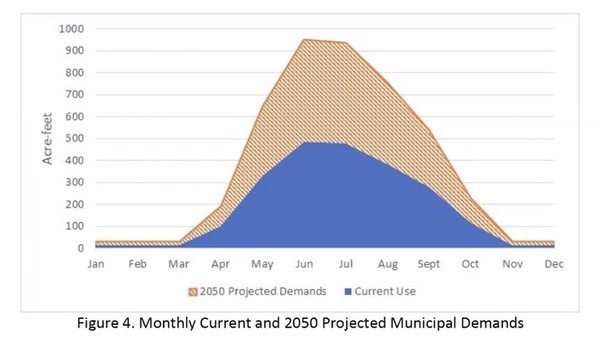
I’ve spent the past 20 years writing about Pagosa Springs, and many of those stories have concerned our community’s water needs. What the Wilson Water Group did not show, in the graph above, and what attorney Kane did not explain at the October 10 SWCD meeting, is that the blue “Current Use” curve for PAWSD water, shown for 2022, is for all practical purposes identical to the “Current Use” curve for 2002, 2003, 2004, 2005, 2006, 2007…
In other words… PAWSD drinking water sales in 2022 were basically the same as they were back in 2002 — twenty years earlier — even though the community’s population had since grown by about 32%.
We have apparently learned how to use less water, per capita, with each passing year.
Here’s a graph comparing the Harris Water Engineering projections of future water demand (in Acre-Feet), published in 2007 and used to justify the purchase of the Running Iron Ranch… compared with actual PAWSD water sales since 2001 (in Acre-Feet).
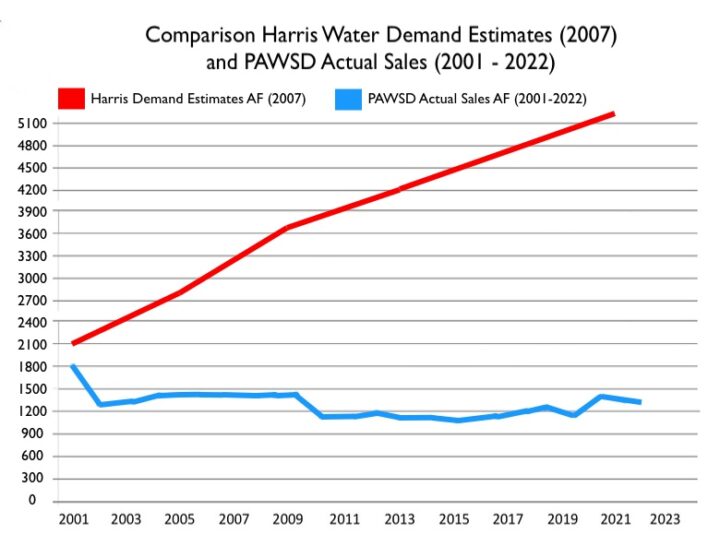
This fact suggests that the Wilson Water Group graph, shared by attorney Jeff Kane, was highly imaginative, and not at all scientific. One might even go so far as to suggest that the entire 26-page WWG report is highly imaginative.
Mr. Kane also shared the following statements with the SWCD Board: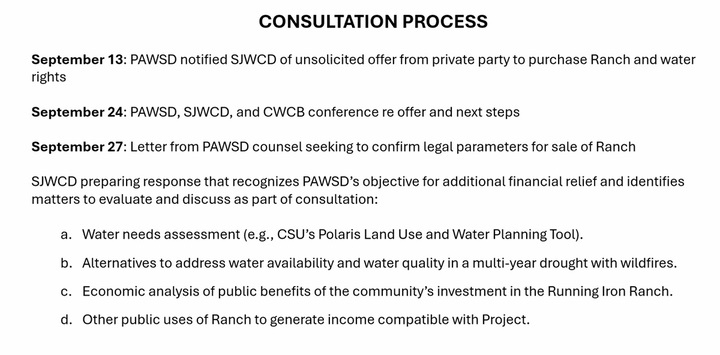
Considering the highly imaginative “water needs assessment” performed by Wilson Water Group — and fully accepted by SJWCD, in spite of serious questions raised by PAWSD Board members — the idea that SJWCD and PAWSD could now cooperate on yet another assessment seems, to me, rather unlikely.
In the view of the PAWSD Board and their legal advisors, PAWSD has the right to sell the Running Iron Ranch “at their sole discretion”, according to an agreement with Colorado Water Conservation Board (CWCB), the state organization that provided the loan and grant for the property purchase in 2008. The agreement states that PAWSD must make “every effort” to retain the property until 2035, but “every effort” is not defined in the agreement.
Additionally, CWCB has “first right of refusal” to purchase the property at a professionally appraised price, if PAWSD wants to sell the property.
Last month, PAWSD attorney Marcus Lock sent a letter to SJWCD, asking that board to clarify whether they accept the following statements:
- That selling the ranch is within PAWSD’s sole discretion;
- That SJWCD has no right to prevent such a sale; and
- That SJWCD will honor its contractual obligation to execute the deeds that would convey the ranch to a buyer.
SJWCD has not responded to that letter, as of this morning.
Maybe we’ll have something by tomorrow?

